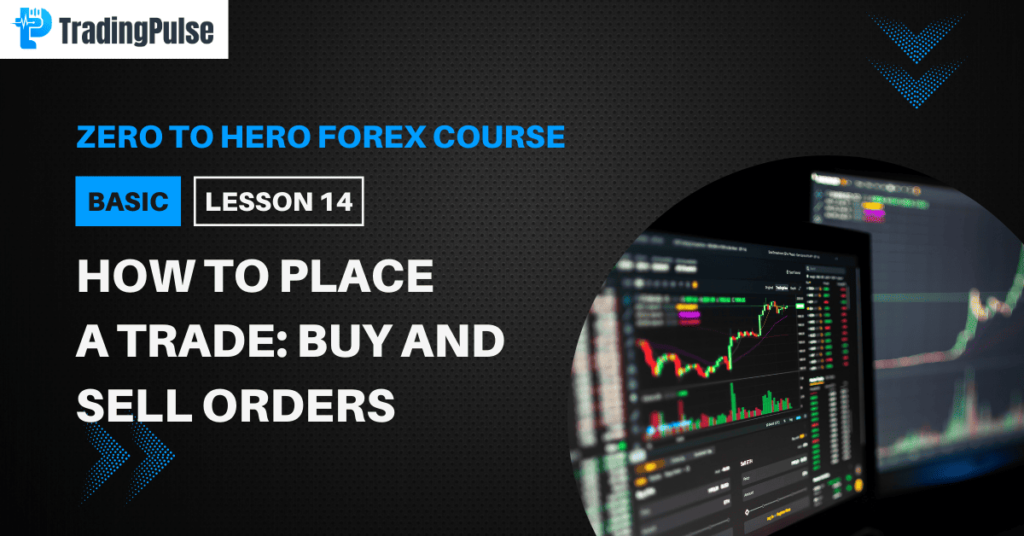
Introduction to Placing Trades in Forex
Placing buy and sell orders is the core activity in Forex trading. Understanding how to effectively execute these orders is essential for any trader. This guide will walk you through the process of placing trades, different order types, and tips for successful execution.
Types of Orders
- Market Order
- Definition: An order to buy or sell a currency pair at the current market price.
- Usage: Used when you want to enter or exit a trade immediately.
- Example: If EUR/USD is quoted at 1.1200/1.1202, a market buy order will be executed at 1.1202.
- Limit Order
- Definition: An order to buy or sell a currency pair at a specified price or better.
- Usage: Used to enter a market at a more favourable price or to take profit.
- Example: If you want to buy EUR/USD at 1.1190, you set a buy limit order at 1.1190.
- Stop Order
- Definition: An order to buy or sell a currency pair once the price reaches a specified level, known as the stop price.
- Usage: Used to limit losses (stop-loss) or to enter the market at a specific level (stop-entry).
- Example: If you bought EUR/USD at 1.1200 and want to limit your loss, you might set a stop-loss order at 1.1180.
- Stop-Limit Order
- Definition: A combination of a stop order and a limit order. The order becomes a limit order once the stop price is reached.
- Usage: Used to enter or exit trades with more control over execution price.
- Example: If EUR/USD reaches 1.1220, you might set a stop-limit order to sell with a stop price at 1.1220 and a limit price at 1.1210.
Steps to Place a Trade
- Choose Your Trading Platform
- Select a reliable trading platform such as MetaTrader 4 (MT4), MetaTrader 5 (MT5), or any other platform provided by your broker.
- Open the Trading Platform
- Log in to your trading account and navigate to the trading section of the platform.
- Select the Currency Pair
- Choose the currency pair you want to trade from the available list. For example, EUR/USD, GBP/JPY, etc.
- Determine Your Trade Size
- Decide the lot size for your trade. Standard lot (100,000 units), mini lot (10,000 units), or micro lot (1,000 units).
- Choose Order Type
- Decide whether you want to place a market order, limit order, stop order, or stop-limit order.
- Set the Order Parameters
- For limit and stop orders, specify the entry price. For stop-loss and take-profit, set the appropriate levels to manage risk.
- Review and Place the Order
- Double-check the details of your trade, including the currency pair, order type, trade size, and order parameters. Confirm and place the order.
Example of Placing a Buy Trade
- Currency Pair: EUR/USD
- Trade Size: 1 mini lot (10,000 units)
- Order Type: Market Order
- Execution Price: 1.1202 (current ask price)
- Stop-Loss: 1.1180
- Take-Profit: 1.1240
Steps:
- Select EUR/USD.
- Choose 1 mini lot.
- Select “Buy” and “Market Order.”
- Set stop-loss at 1.1180.
- Set take-profit at 1.1240.
- Place the order.
Tips for Successful Trade Execution
- Monitor Market Conditions: Stay updated with market news and economic events that could impact your trades.
- Use Stop-Loss Orders: Always use stop-loss orders to manage risk and protect your capital.
- Avoid Overleveraging: Use leverage wisely to avoid significant losses. Start with lower leverage and increase it as you gain experience.
- Practice with a Demo Account: Before trading with real money, practice on a demo account to get comfortable with placing orders and executing trades.
Conclusion
Placing buy and sell orders is fundamental to Forex trading. By understanding different order types and following a structured process, traders can execute trades effectively and manage their risk. Continuous practice and staying informed about market conditions will enhance your trading skills and success.
